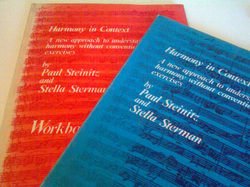M
This is Crisantemi by G. Puccini, not one of his most famous works, but a truly beautiful one.
|
Finally I took the time to upload a little bit of the work done during the Young Conductors Development Programme with Milton Keynes City Orchestra led by Sian Edwards. It was a terrific weekend where we had the opportunity to work fantastic music with a great teacher and orchestra. And I made friends for life. M This is Crisantemi by G. Puccini, not one of his most famous works, but a truly beautiful one.
1 Comment
Yes indeed! You'll have more awareness, you'll be calmer, will breath better and with the music, and you'll play freer than you ever did before. You will sound better.
I didn't approach yoga as early as I should have and until very recently any sort of advice I received along those lines was more or less quickly rejected with the usual "I have no time for that", or "I rather practice [piano] more". I was sceptic, didn't believe it could affect my playing and didn't have time to waste. It is another silly excuse, but probably the fact that such a recommendation would't come directly from a musician didn't help! Alas, we can be so blind sometimes... Yoga has a profound effect both in your body and mind, and consequently it will show in the way you play. Yoga brings together mind and body in one, and is precisely that unity, that coherence in oneself that we need to have in order to truly let the music flow from us, and through us. I could go on and on , but I want to keep it really brief and hopefully effective, the main message being, TRY IT! Moreover, you don't need to spend a fortune committing months in a studio or gym if you are not ready for it; there are plenty of fantastic tutorials online to awaken your curiosity and help doing the first and most important steps! This is my little contribution. I have to thank my piano teacher Laura Roberts for having shown it to me. I'll finish with some links: this is the Yoga Journal with plenty of info and here goes a Sun Salutation with Esther Ekhart. It can take as little as 10 minutes a day, but it will make such a difference! You can take my word for it! As I said earlier.. Try it! M. Ps. I have no shares with either the Yoga Journal or Esther! They are two online resources that I like :)  After about 6 months of neglect, I'm back into the blogging mode, at least I will try my best. There are always many topics to be discussed, musical and non musical alike. Specially now that the situation in my home country is getting so desperate and crying out loud through the internet seems to be the only thing one can do from the distance. At least to redeem a bit of guilt. However, after such a long time without writing a single line, I need a bit of time to get back to it con tutta forza and since I have thoroughly enjoyed this week's reading, I'm going to focus on that. I got out of the Royal Academy library Harmony in Context A new approach to understanding harmony without conventional exercises, by Paul Steinitz and Stella Sterman. I have to say that it did not disappoint. The book is written in a concise but friendly manner, and it precisely does what it promises, contextualizing the use of the different harmonic devises through the scope of musical history. I found specially uplifting to see that it doesn't focus in mere nomenclature of chords, but in the functionality of harmony, revising it's real usage by the composers. The book inspires curiosity for harmonic syntax, rather than being an aseptic chord (-progression) list. Apart from the examples provided in the book, there is a separate workbook with a set of very interesting exercises, based mostly on musical excerpts, that I think make of this method quite a hands on one. I fully recommend. M. |
My CornerNews, Thoughts, Reviews... Miscellaneous! Archives
March 2013
Categories
All
|
